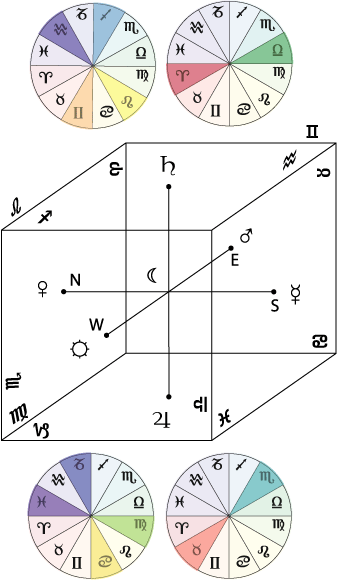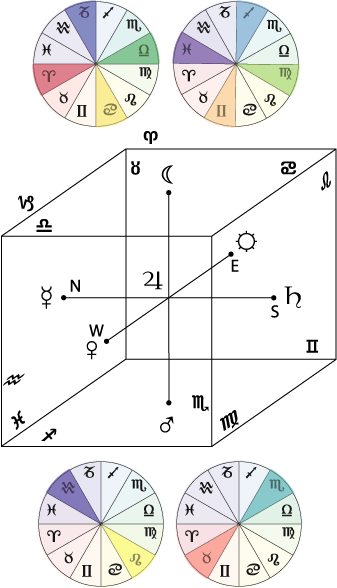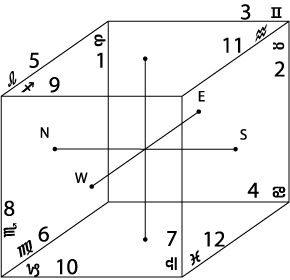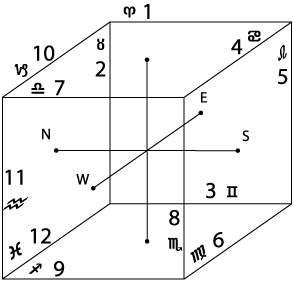It was the Kabbalists themselves who preserved the correct text, initially concealing it from outsiders.
Around 1550, Rabbi Moshe Cordvero, leader of the Safed school and the greatest Kabbalist of the day,
sifted through the ten best manuscripts available, choosing the one most closely fitting the tradition
of the Kabbalists. A generation later, the text was further refined by the Ari (Rabbi Yitzchak Luria),
one of the greatest Kabbalists of all time. This text, known as the Ari Version, was published a number
of time, usually as part of some other collection. It resembles the Short Version in many ways, but
there are some very significant differences in assignment. In general, the Ari Version is the only one
which is in agreement with the Zohar.
Aryeh Kaplan, Sefer Yetzirah, Aronson, 1995 p. xxv
|
Kaplan is not alone in considering the Ari-Gra versions of the Sepher Yetsira and Cube of Space
to be the "correct" ones, even though they represent radical departures both from the 9th and
10th century "canonical" recensions ("The differences of reading between the three recensions are not
as many as is generally assumed. Ithamar Gruenwald, "A Preliminary Critical Edition of Sepher Yetzirah" and
Planetary Attributions in the SY),
as well as ancient and classical understanding of the heavenly spheres and planetary order. The classical
order of the spheres begins with Bayt forming Shabatai/Saturn and ends with Tav forming Lavanah/Moon. The Ari-Gra
version begins with Bayt forming Lavanah and ends with Tav forming Tsedeq/Jupiter.
In the absence of other justifications, a few structural observations can be made.
In regard to zodiacal placements, the Lurianic Cube simplifies the structure of opposing
signs by placing all the cardinal signs at the top, all the fixed signs on the verticals
and all the mutable signs on the bottom of the cube. In regard to planetary placments,
the Tzadik ("Faith of the Righteous One") is found at the center and none of the binomials
correspond to early versions of the Sepher Yetzirah or classical cosmology (where the
planets are paired: Saturn-Jupiter, Mars-Sun, Venus-Mercury, Moon).
This construction appears to be yet another arbitrary formalism instituted by commentators
(in this case the 18th century Gaon of Vilna) who had long since lost the connection with
the underlying interrelated structures they are attempting to describe. See
Sephirotic Systems in the
Sepher Yetsira and Post-Zohar Kabbalah. The position of Tsedeq here is as suggestive of special
interests as Mercury in the Golden Dawn system.
| Sepher Yetsira / Sefer Yetzirah: Comparative Structures in the Cube of Space
|

|
| Short |
|

|
| Gra |
|
| Sepher Yetsira / Sefer Yetzirah: Zodiacal Oppositions in the Short and Gra Versions
|

|
| Short |
|

|
| Gra |
|
| Sepher Yetsira / Sefer Yetzirah: Comparative Structures in the Cube of Space
|
|
Twelve Elementals: Edge Definition in the Short & Gra Sepher Yetsira |
| |
Gra |
Short |
| Letter |
Sign |
Direction |
Planetary Flow |
Direction |
Planetary Flow |
 |
 |
East High |


|
East North |


|
 |
 |
East North |


|
East South |


|
 |
 |
East Low |


|
East High |


|
 |
 |
South High |


|
East Low |


|
 |
 |
South East |


|
North High |


|
 |
 |
South Low |


|
North Low |


|
 |
 |
West High |


|
West South |


|
 |
 |
West South |


|
West North |


|
 |
 |
West Low |


|
West High |


|
 |
 |
North High |


|
West Low |


|
 |
 |
North West |


|
South High |


|
 |
 |
North Low |


|
South Low |


|
|
|
|
|


